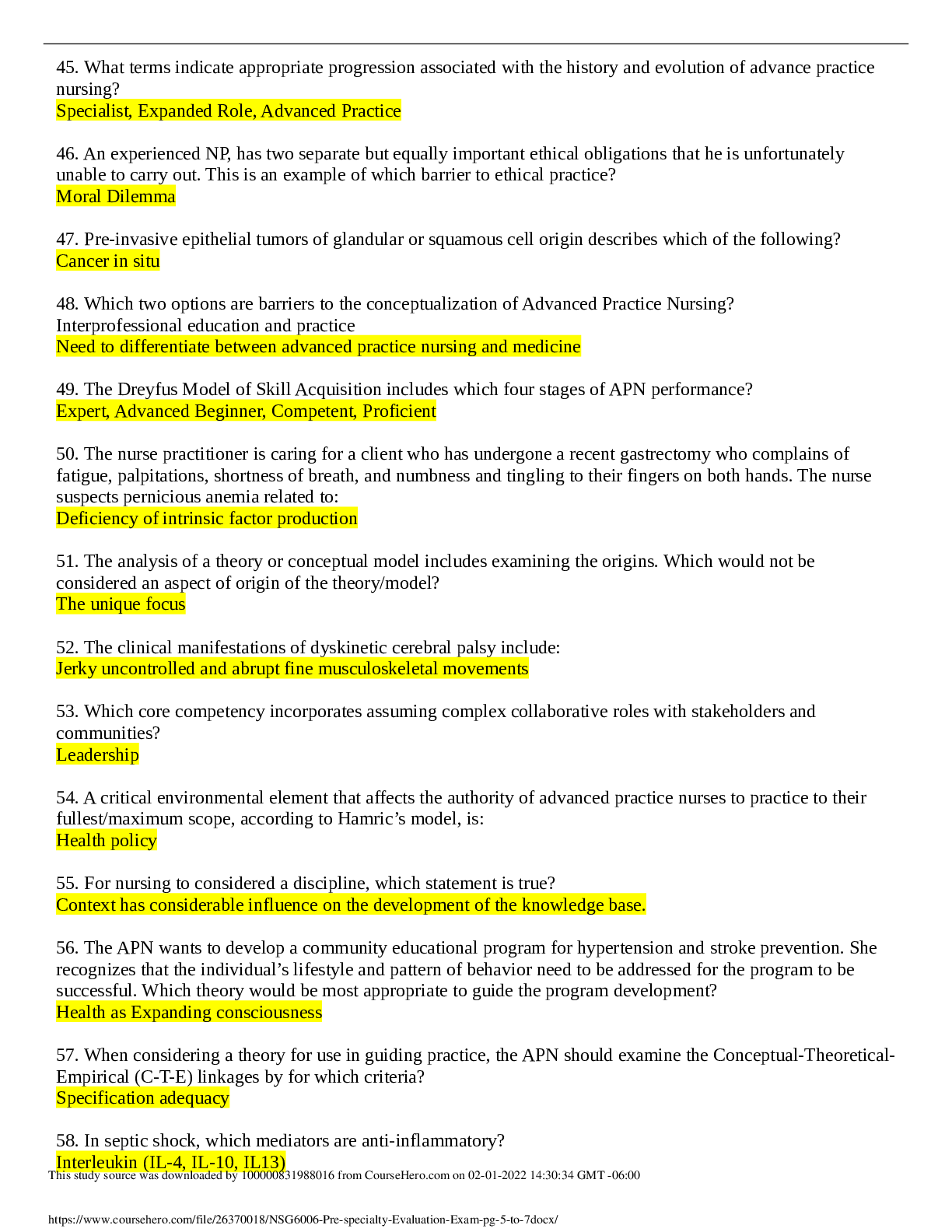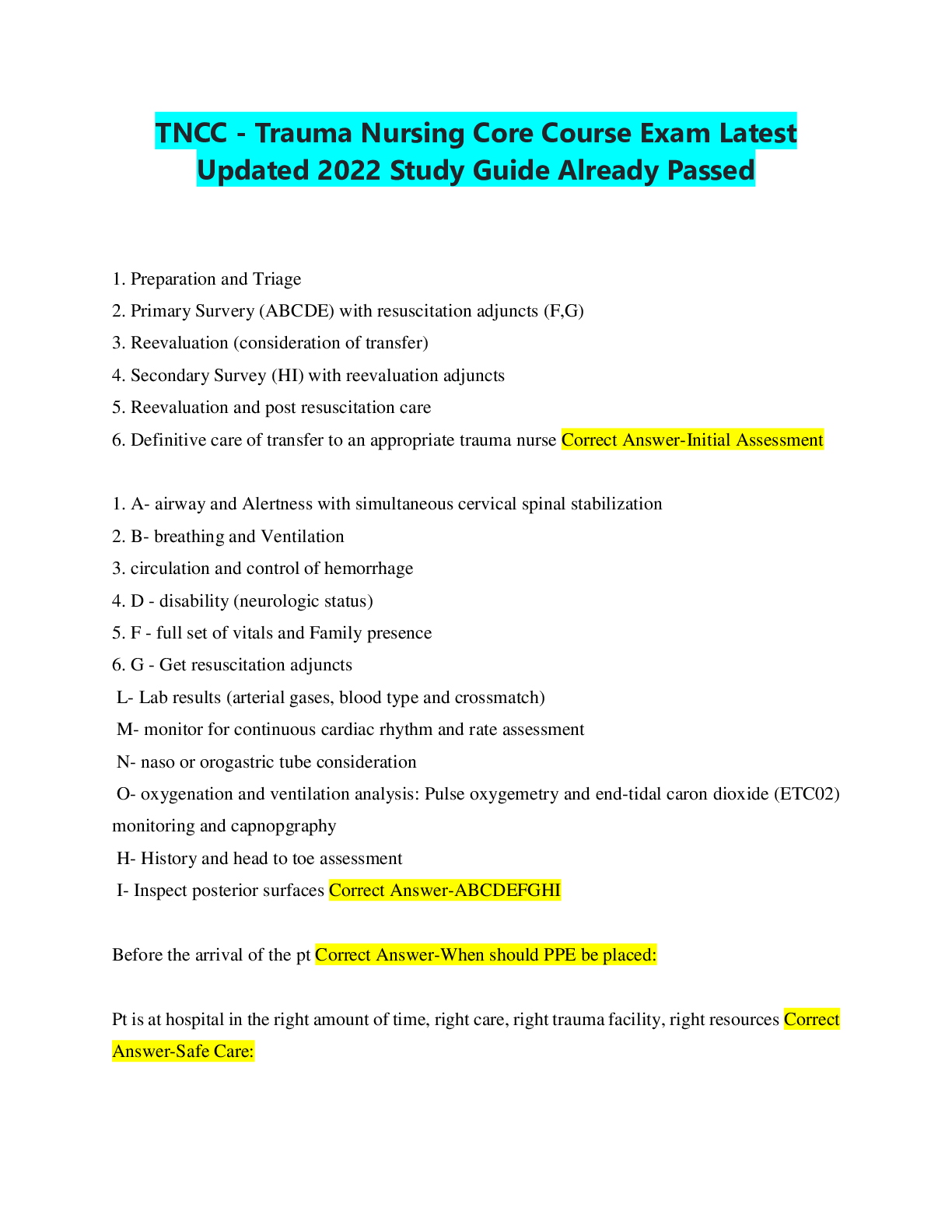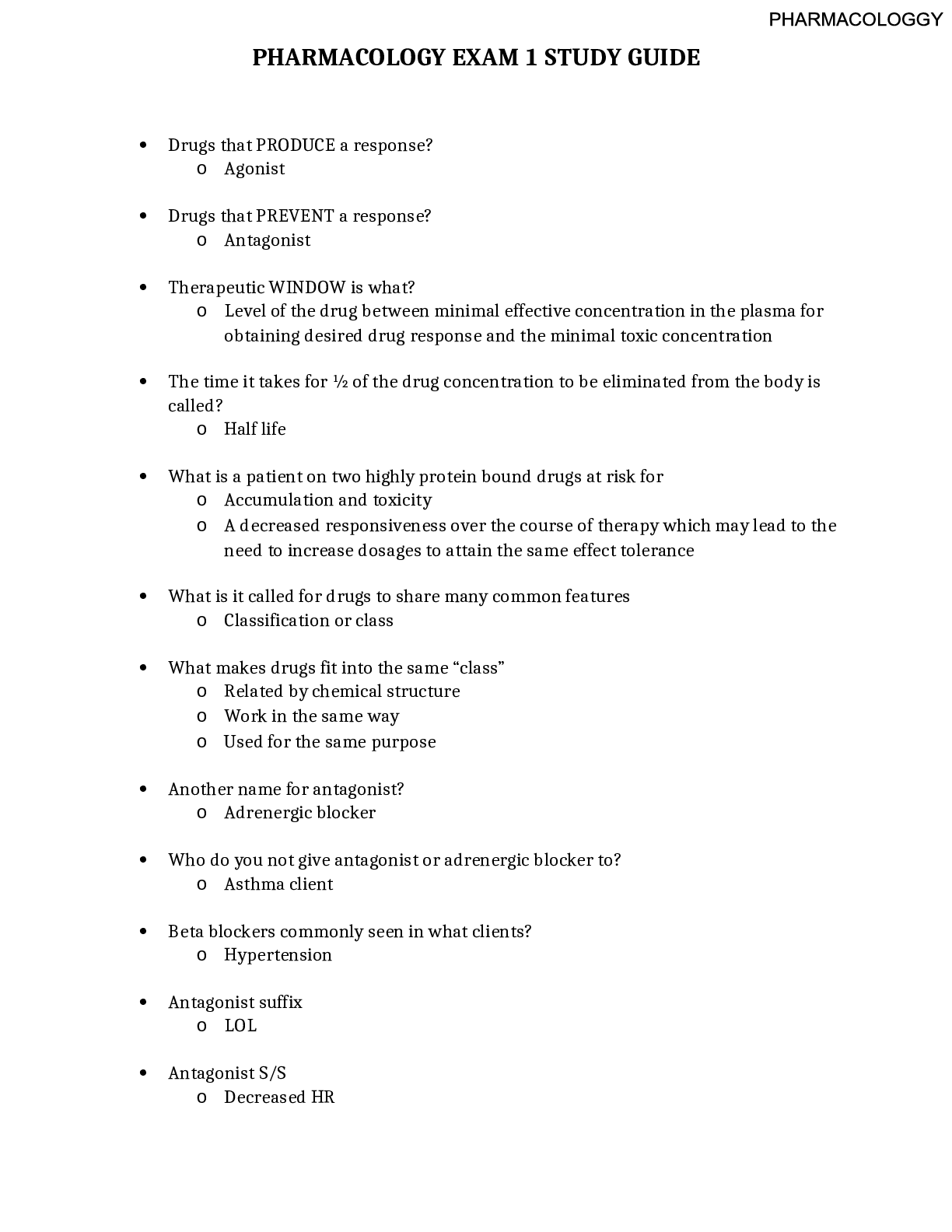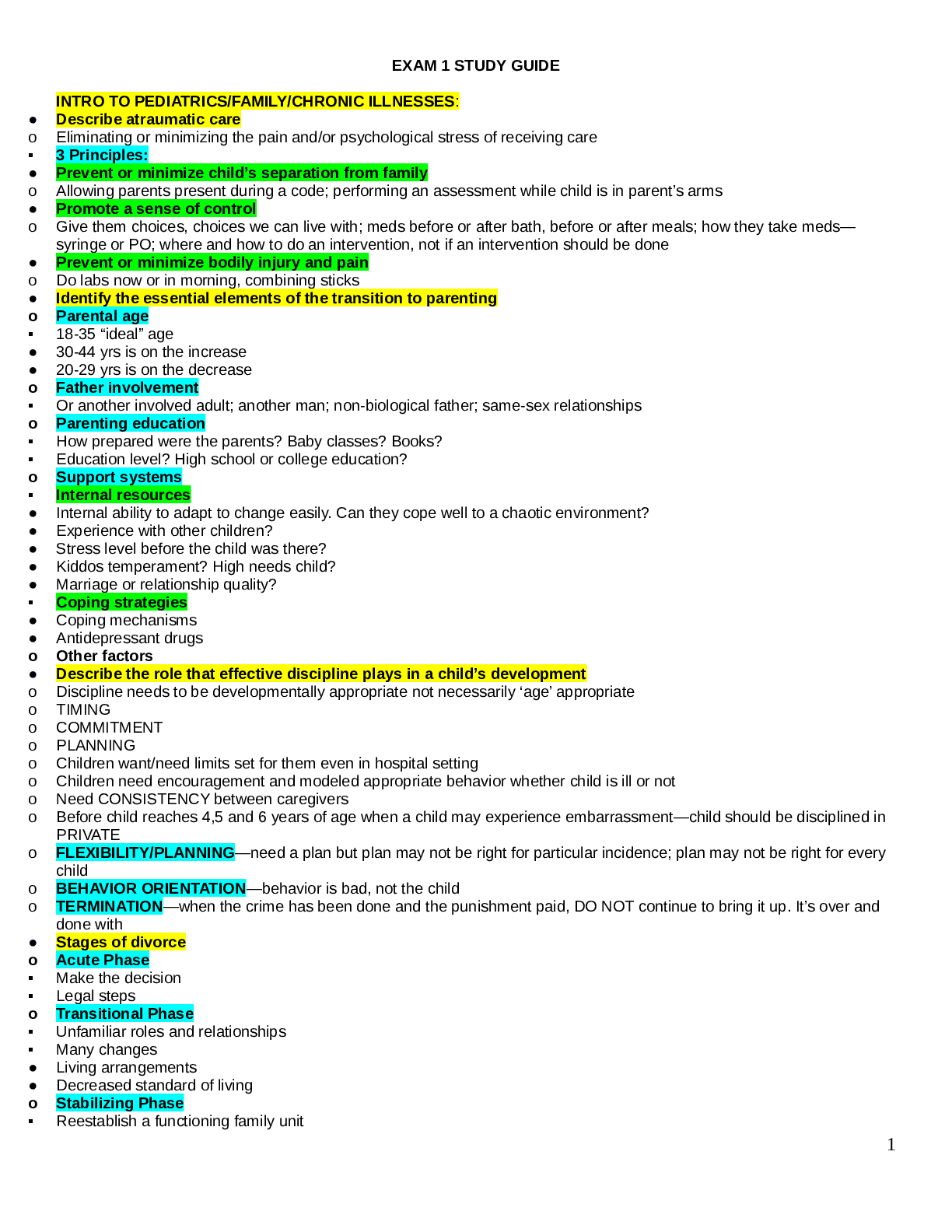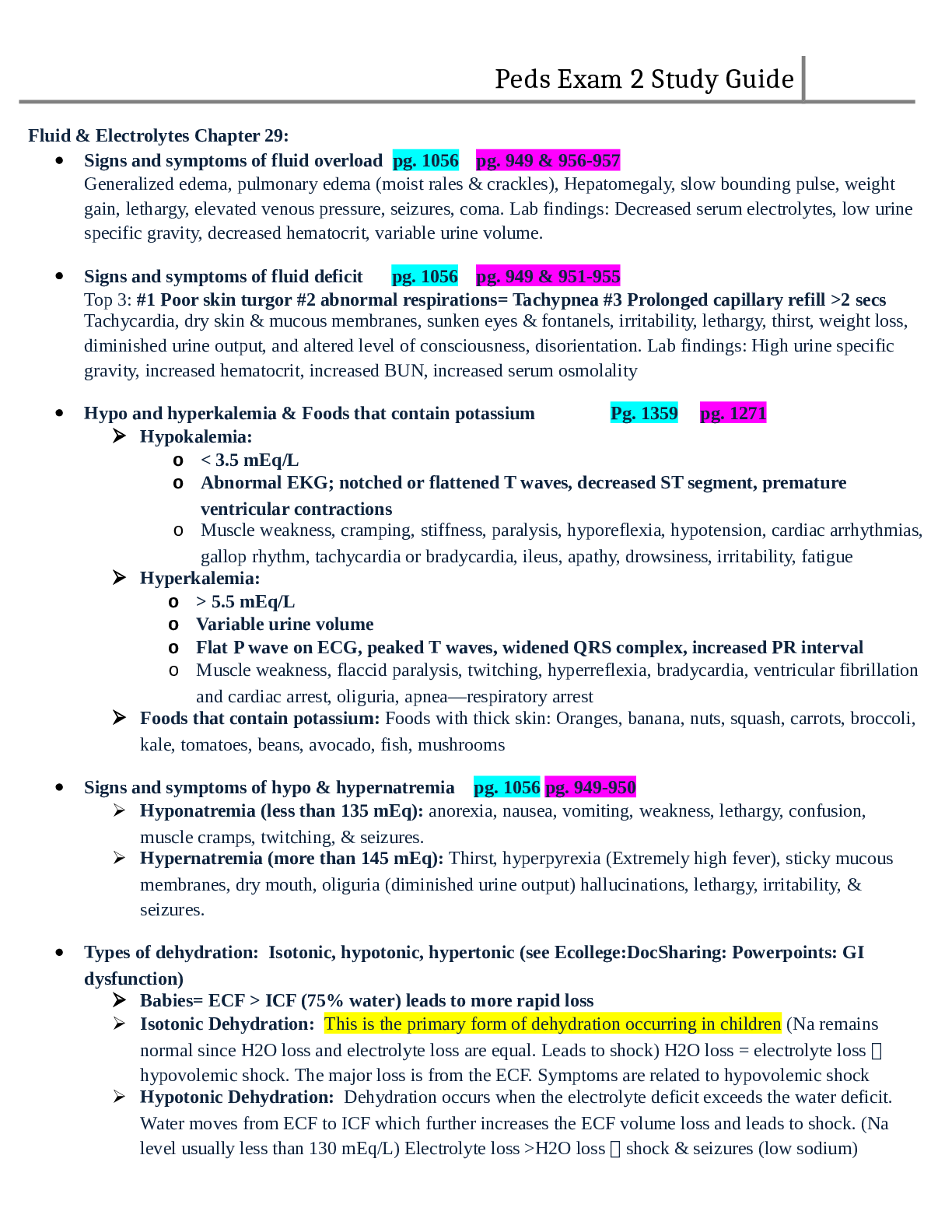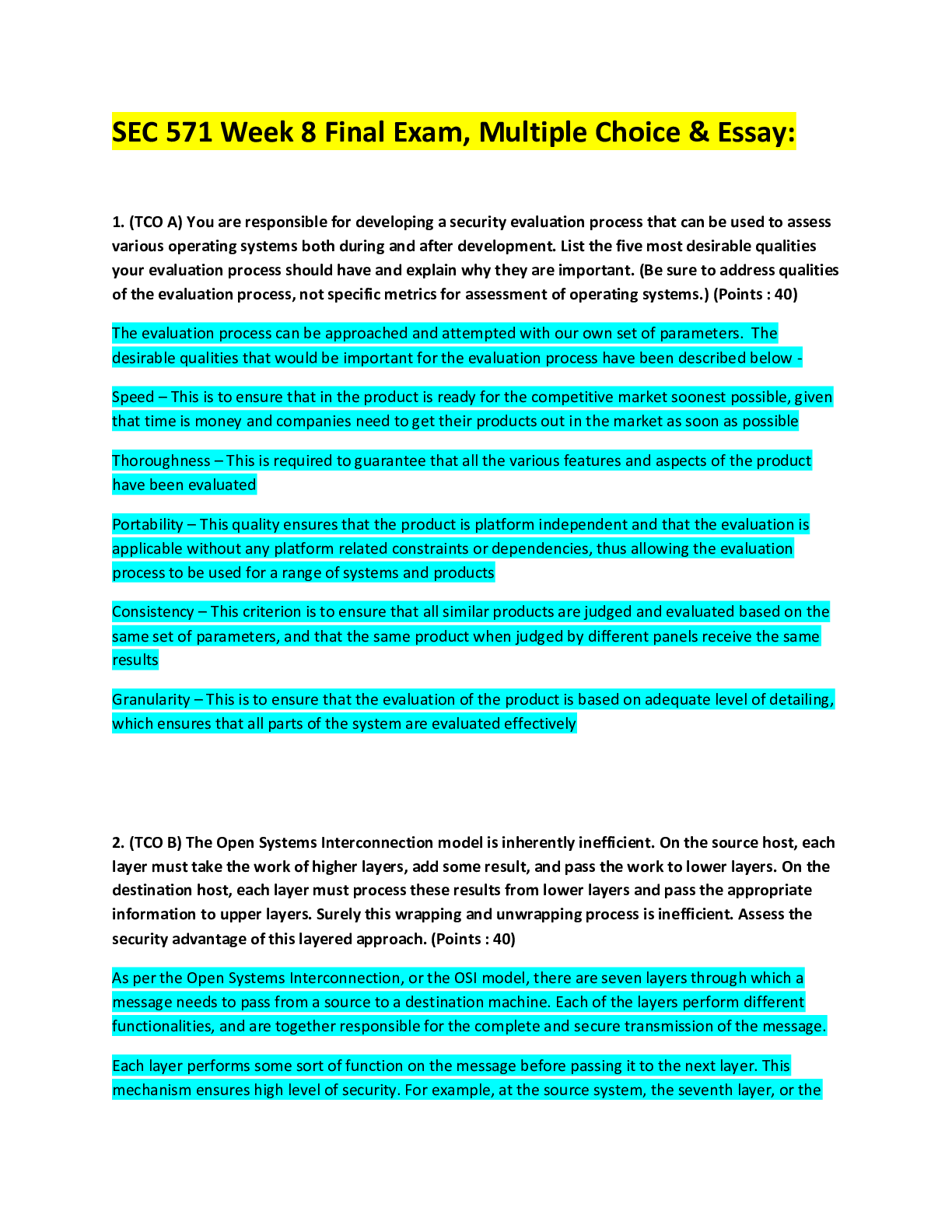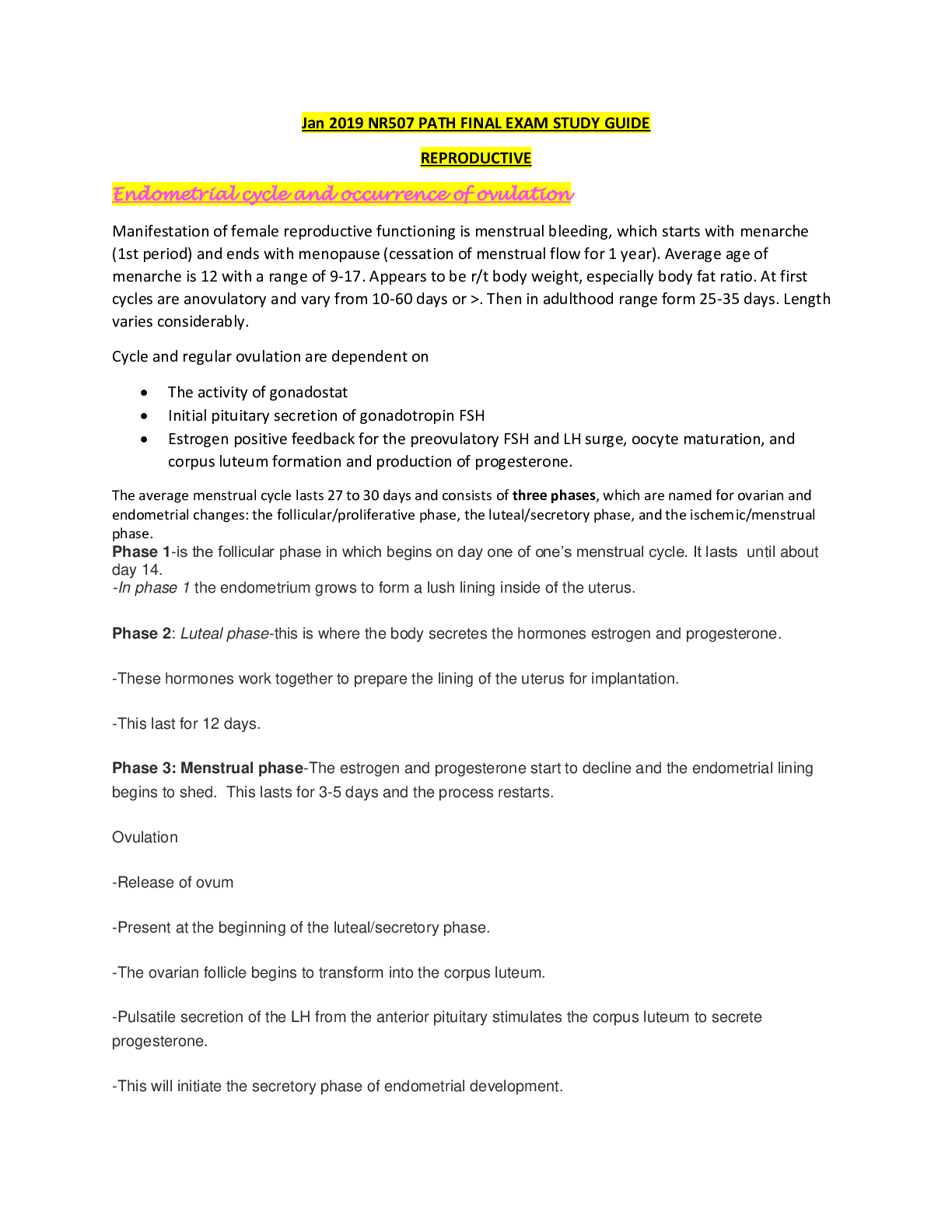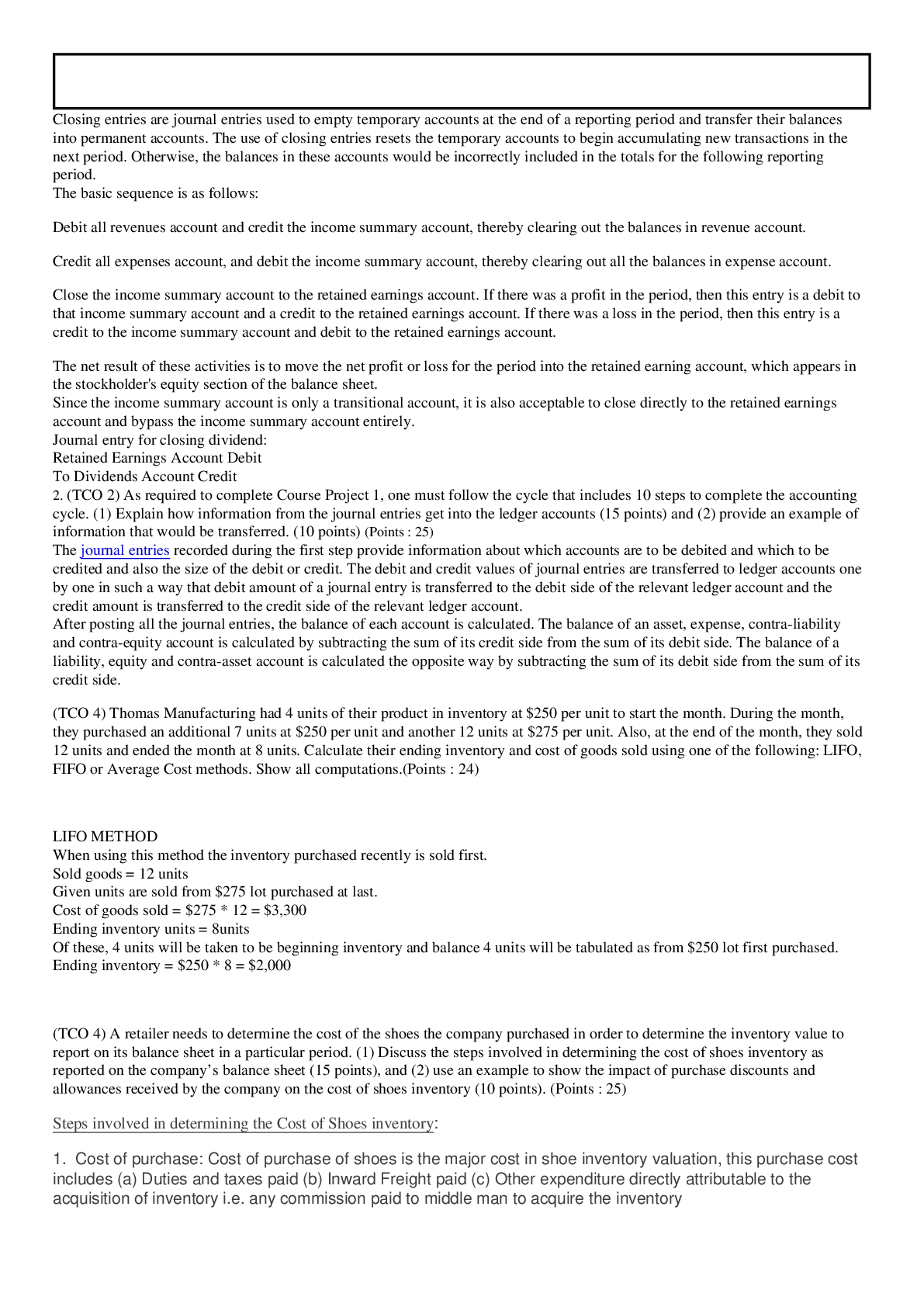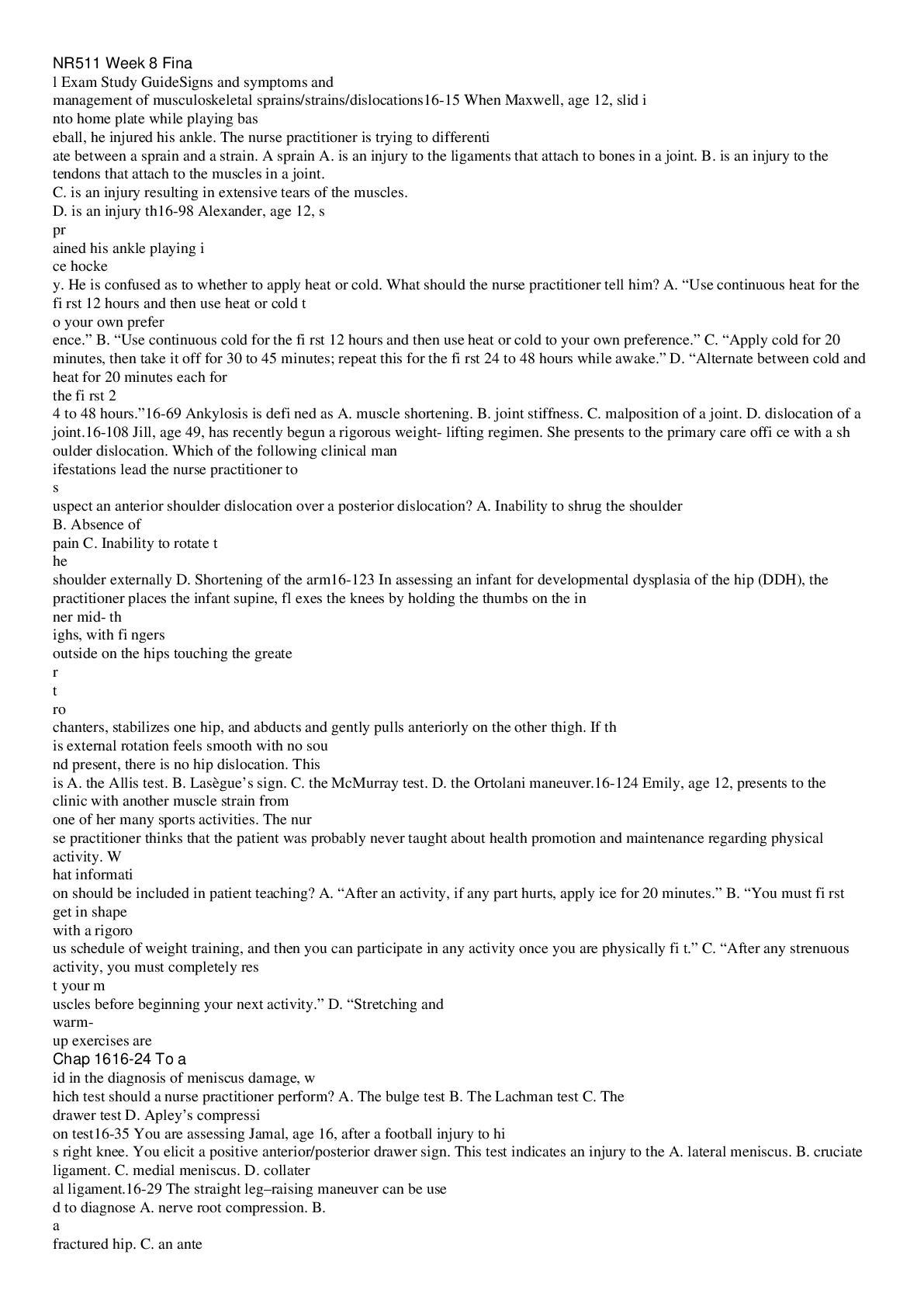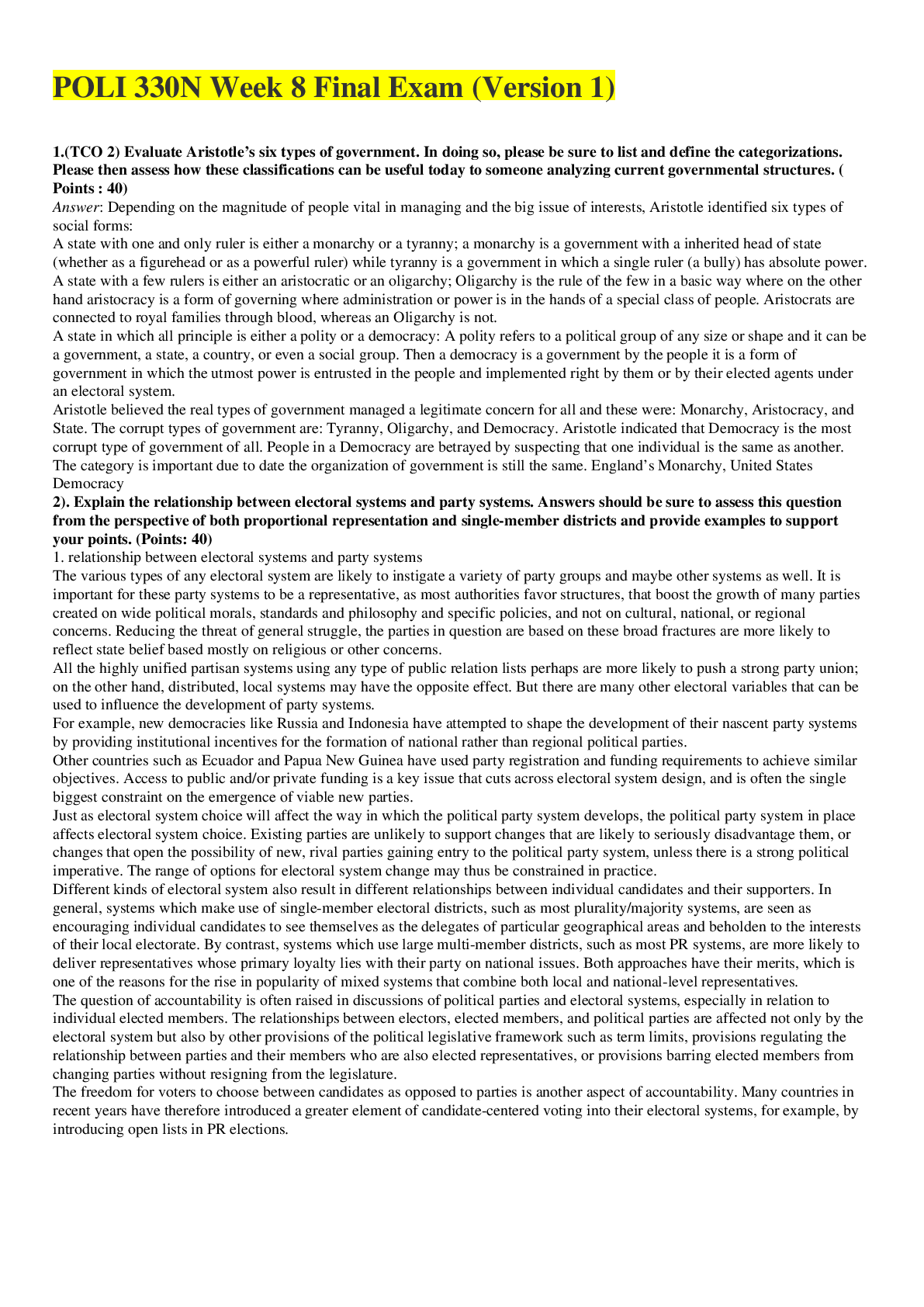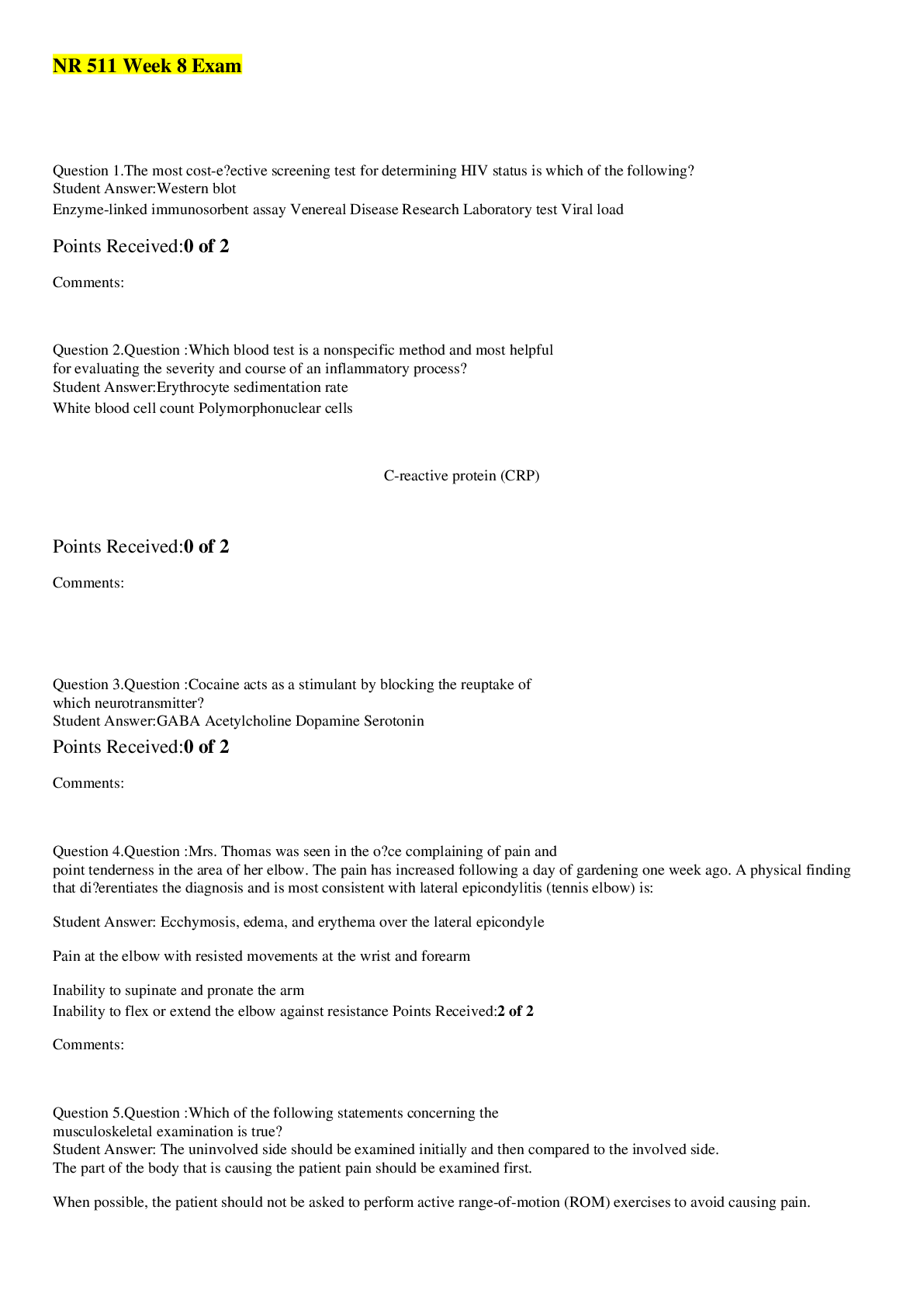Biology > STUDY GUIDE > BIOS 255 Week 8 Final Exam (Essay & Explanatory)-Graded A (All)
BIOS 255 Week 8 Final Exam (Essay & Explanatory)-Graded A
Document Content and Description Below
Final Exam Study Guide AP III Essay questions to know What are innate and adaptive immune systems, how they work and how they interact. Adaptive immunity is the ability of the body to defend i... tself against specific invading agents Antigens are substances recognized as foreign that provoke immune responses Adaptive immunity has both specificity and memory and is divided into 2 types 1 Cell-mediated 2 Antibody-mediated In cell-mediated immunity: An antigen is recognized and bound A small number of T cells proliferate and differentiate into a clone of effector cells The antigen is eliminated In antibody-mediated immunity: An antigen is recognized and bound Helper T cells costimulate the B cell so the B cell can proliferate and differentiate into a clone of effector cells that produce antibodies The antigen is eliminated Innate immunity refers to a variety of body responses that serve to protect us against invasion of a wide variety of pathogens and their toxins. We are born with this kind of immunity Two lines of defense: Nonspecific disease resistance fight a wide variety of invaders. 1 st: Skin and mucous membranes: barriers, antimicrobial substances 2 nd: Internal defenses (cellular defenses), inflammation, and fever Describe the anatomy and functions of the spleen. a. The spleen is the largest single mass of lymphatic tissue in the body. It is found in the left hypochondriac region between stomach and the diaphragm. It is composed of white pulp and red pulp. Red pulp filters blood and gets rid of old or damaged blood cells. White pulp consists of immune cells and helps fight infection. The spleen acts as a blood filter, if it detects bad bacteria, viruses in the blood, it and the lymph nodes create lymphocytes which act as defenders. What is ventilation, external respiration and internal respiration. What are their functions and Location. 1. Pulmonary ventilation, or breathing, is the movement of air between the atmosphere and the lungs that occurs when we inhale and exhale 2. External respiration is the movement of oxygen from the alveoli into pulmonary capillaries and carbon dioxide from pulmonary capillaries to the alveoli. 3. Internal respiration is the movement of oxygen from capillaries into body cells and carbon dioxide from body cells into capillaries. Neural control of ventilation including brain centers, sensory and motor signals. Respiratory center- Neurons in the pons and medulla oblongata of the brain stem that regulate breathing. It is divided into the medullary respiratory center and the pontine respiratory center. Within the medullary respiratory center, you find two respiratory groups, the ventral respiratory group (AKA expiratory area) and the dorsal respiratory group (AKA inspiratory area). The DRG generates impulses to the diaphragm via the phrenic nerves and the external intercostals via the intercostal nerves. These impulses trigger contraction of these muscles which in turn execute inhalation. When the nerves are not firing, this passive relaxation allows recoil of the lungs and thoracic wall, passive exhalation. The VRG is only activated during forceful inhalation and trigger the accessory muscles to work. An important part of the VRG is the Pre-Botzinger Complex which is believed to be important in the generation of the rhythm of breathing (Pacemaker cells) Medulla oblongata receives signals & increases ventilation; pons controls rate of involuntary respiration; motor cortex; respiratory chemoreceptors Transport of oxygen and carbon dioxide are transported in the blood. How does loading/unloading of these gases take place in the lungs vs. tissues. Dissolved in plasma (1.5%) (= blood PO2) Remember, O2 is not very soluble in blood! 2. Bound to hemoglobin in RBCs (98.5%) The final step in the exchange of gases between the external environment and the tissues is the transport of oxygen and carbon dioxide to and from the lung by the blood. Oxygen is carried both physically dissolved in the blood and chemically combined to hemoglobin. Carbon dioxide is carried physically dissolved in the blood, chemically combined to blood proteins as carbamino compounds, and as bicarbonate. Oxygen is transported both physically dissolved in blood and chemically combined to the hemoglobin in the erythrocytes. Much more oxygen is normally transported combined with hemoglobin than is physically dissolved in the blood. Without hemoglobin, the cardiovascular system could not supply sufficient oxygen to meet tissue demands. Oxygen is loaded in blood in the pulmonary capillaries where the oxygen tension is 100 mm Hg as a result of alveolar ventilation. Oxygen is unloaded from the blood in the peripheral tissues where the oxygen tension is roughly 40 mm Hg as a result of peripheral tissue oxygen consumption. Calculation of minute ventilation and mean arterial pressure (862) The minute ventilation (MV)- the total volume of air inhaled and exhaled each minute- is respiratory rate multiplied by tidal volume: MV = 12 breaths/ min x 500 mL/ breath = 6 liters/ min 741) Mean arterial pressure (MAP), the average blood pressure in arteries, is roughly one-third of the way between the diastolic and systolic pressures. It can be estimated as follows: MAP = diastolic BP + 1/3 (systolic BP−diastolic BP) Amount of air that moves in & out of lungs during normal breathing (500 ml normal) Flow of blood in the heart Blood flows through the heart first through the right atrium. It is deoxygenated blood that comes from the inferior vena cava, superior vena cava, and coronary sinus. The blood then goes through the tricuspid valve then to the right ventricle. After the right ventricle it goes through the pulmonary valve then to the pulmonary artery .the blood then goes to the lungs to become oxygenated.Oxygenated blood returns to the heart through the pulmonary veins into the left atrium. It goes through the mitral valve then left ventricle. It then goes to the aortic valve then to the aorta then to the body. Blood cell lines 3 blood cell lines under MyeloidMAST TISSUE RBC-(Erythrocyte), CFU-E, Proerythroblast Platelets-Megakaryoblast, CFU-Meg WBC-Eosinophil, CFU-GM, Eosinophil Myeloblast- GRANULOCYTE WBC-Basophil, CFU-GM, Basophilic myeloblast- GRANULOCYTE WBC-Neutrophil, CFU-GM, Myeloblast- GRANULOCYTE WBC-Monocytes, CFU-GM, Monoblast- AGRANULOCYTE- MACROPHAGE TISSUE Lymphoid WBC-T lymphocytes (T cell)-t lymphoblast- AGRANULOCYTE WBC- B lymphocytes (B cell), B lymphoblast- AGRANULOCYTE Natural Killer (NK) NK lymphoblast During hemopoiesis, some of the myeloid stem cells differentiate into progenitor cells (prō-JEN-i-tor). Other myeloid stem cells and the lymphoid stem cells develop directly into precursor cells (described shortly). Progenitor cells are no longer capable of reproducing themselves and are committed to giving rise to more specific elements of blood. Some progenitor cells are known as colony-forming units (CFUs).Following the CFU designation is an abbreviation that indicates the mature elements in blood that they will produce: CFU–E ultimately produces erythrocytes (red blood cells); CFU–Meg produces megakaryocytes, the source of platelets; and CFU–GM ultimately produces granulocytes (specifically, neutrophils) and monocytes (see Figure 19.3). Progenitor cells, like stem cells, resemble lymphocytes and cannot be distinguished by their microscopic appearance alone. Lymphatic drainage, structures involved lymph drains into venous blood through the right lymphatic duct and the thoracic duct at the junction of the internal jugular and subclavian veins Lymphatic vessels flow into a series or chain of lymph nodes where lymph is filtered. Within a body region, the lymph vessels exiting the last lymph nodes in each chain of nodes merge to form lymph trunks. Lymph trunks merge to form two main ducts, the thoracic duct (left lymphatic duct) and the right lymphatic duct. In the abdominal area, lymph trunks merge to form a sac-like reservoir called the cysterna chyli. The long thoracic duct begins at the cysterna chyli and continues superiorly to drain the lymph from the legs, abdomen, left arm, and left side of the thorax, neck, and head into the left subclavian vein. The right lymphatic duct is the lesser and very short duct that drains lymph from the right arm via the right jugular trunk and right side of the thorax, neck, and head via the right subclavian trunk. Each duct enters the subclavian vein at its juncture with an internal jugular vein to drain lymph into venous blood. Functions of lymphatic system . Drains excess interstitial fluid. Lymphatic vessels drain excess interstitial fluid from tissue spaces and return it to the blood. This function closely links it with the cardiovascular system. In fact, without this function, the maintenance of circulating blood volume would not be possible. 2. Transports dietary lipids. Lymphatic vessels transport lipids and lipidsoluble vitamins (A, D, E, and K) absorbed by the gastrointestinal tract. 3. Carries out immune responses. Lymphatic tissue initiates highly specific responses directed against particular microbes or abnormal cells. Antibodies: salient features gG antibodies 80% of serum antibodies; crosses placenta from mother to fetus; shape of Y IgA antibodies 10-15% of serum antibodies; found in secretions; dimers (2 units) IgM antibodies 5-10% of serum antibodies; first Ab produced in response to infection; pentamer IgD antibodies 0.2% of serum antibodies; in blood, lymph, & on B cells; monomer IgE antibodies 0.1% of serum antibodies; on ma [Show More]
Last updated: 2 years ago
Preview 1 out of 20 pages

Buy this document to get the full access instantly
Instant Download Access after purchase
Buy NowInstant download
We Accept:

Reviews( 0 )
$13.00
Can't find what you want? Try our AI powered Search
Document information
Connected school, study & course
About the document
Uploaded On
May 01, 2022
Number of pages
20
Written in
Additional information
This document has been written for:
Uploaded
May 01, 2022
Downloads
0
Views
100
.png)




